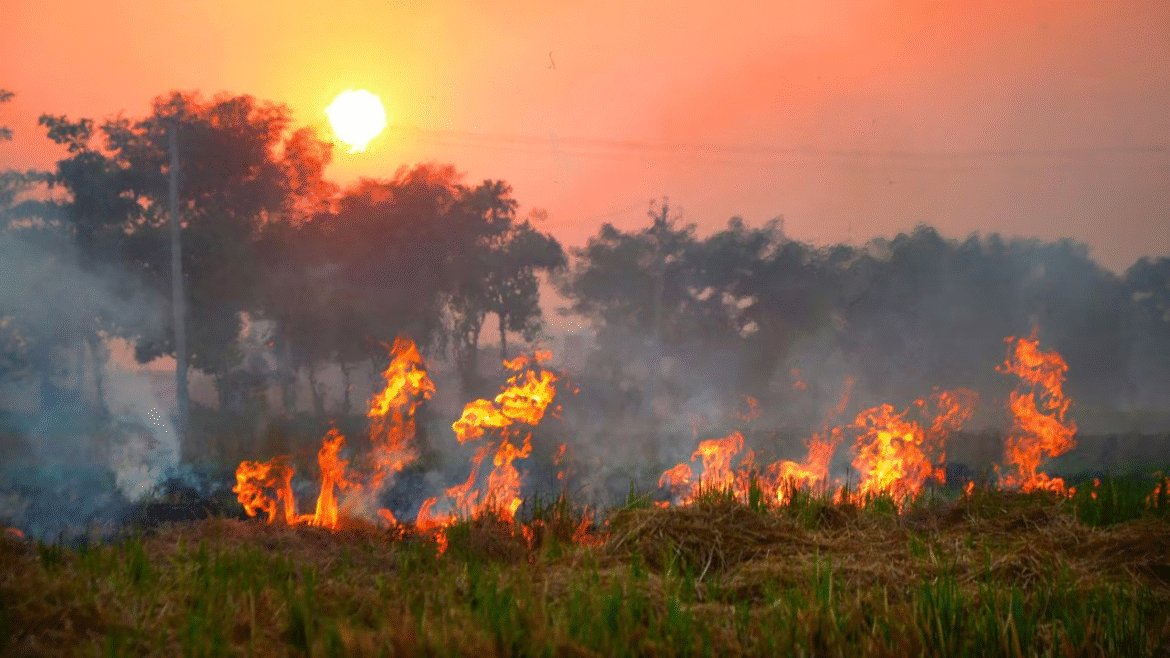AI Generated Summary
- While stubble burning in Punjab, Haryana, Madhya Pradesh, and western Uttar Pradesh remains a major concern, satellite data now points to significant farm fire activity in neighbouring Pakistan — particularly in the Punjab province — as a key contributor to the haze blanketing the region.
- Ravindra Khaiwal, Professor of Environmental Health at PGIMER Chandigarh and Nodal Faculty Officer at the Centre of Excellence on Climate Change and Air Pollution-Related Illness (Ministry of Health), highlighted a sharp disparity between fire incidents in Indian and Pakistani Punjab.
- As smog and shallow fog begin forming during the evenings, experts caution that worsening meteorological conditions and cross-border emissions could push pollution levels higher in the coming weeks, underlining the urgent need for regional cooperation to tackle a shared environmental crisis.
As the air quality across northern India continues to worsen, environmental experts warn that the causes extend beyond India’s borders. While stubble burning in Punjab, Haryana, Madhya Pradesh, and western Uttar Pradesh remains a major concern, satellite data now points to significant farm fire activity in neighbouring Pakistan — particularly in the Punjab province — as a key contributor to the haze blanketing the region.
Recent satellite imagery has revealed widespread stubble burning across Pakistan’s border districts, where farmers are believed to be clearing paddy residue ahead of the next sowing cycle. The imagery shows thick smoke plumes drifting eastward toward India, intensifying transboundary air pollution.
Dr. Ravindra Khaiwal, Professor of Environmental Health at PGIMER Chandigarh and Nodal Faculty Officer at the Centre of Excellence on Climate Change and Air Pollution-Related Illness (Ministry of Health), highlighted a sharp disparity between fire incidents in Indian and Pakistani Punjab.
“Between October 8 and 15, the fire count in Indian Punjab was recorded at 47, while Pakistan’s Punjab reported 1,161,” Dr. Khaiwal said. “This data clearly shows higher burning activity across the border.”
According to the analysis, Pakistan’s Kasur, Okara, and Pakpattan districts have emerged as stubble-burning hotspots, with Okara alone accounting for over 36 percent of all fires in the province. Experts say prevailing northwesterly winds, moving at speeds of 6–12 km/hour, are likely carrying smoke and fine particulate matter into southeastern parts of India. The flat terrain of the Punjab plains further allows pollutants to travel unhindered across borders.
Officials from India’s Commission for Air Quality Management (CAQM) have acknowledged the challenge of managing transboundary emissions. “We are witnessing farm fires near the border on the Pakistan side. Unfortunately, such activities lie beyond our jurisdiction,” a senior CAQM expert said.
Interestingly, while scientists in Indian Punjab have reported a decline in local stubble-burning incidents, air quality levels have not shown a corresponding improvement. This has raised concerns that some fires in Pakistan may be occurring under atmospheric or temporal conditions that evade satellite detection. Afternoon satellite images have captured dense smoke drifting eastward, confirming the regional nature of the pollution.
Despite growing evidence, the issue has yet to be officially flagged. Punjab Pollution Control Board officials suggested that Basant Garg, Secretary of Agriculture and Farmers’ Welfare, could comment on the matter, but he was unavailable despite repeated attempts to reach him.
On Thursday, 12 farm fire incidents were reported within Punjab. Meanwhile, air quality indices across the state remained moderate — 125 in Jalandhar, 106 in Ludhiana — while PM10 levels in Patiala reached 104, posing respiratory discomfort, especially for patients with existing lung conditions.
As smog and shallow fog begin forming during the evenings, experts caution that worsening meteorological conditions and cross-border emissions could push pollution levels higher in the coming weeks, underlining the urgent need for regional cooperation to tackle a shared environmental crisis.




